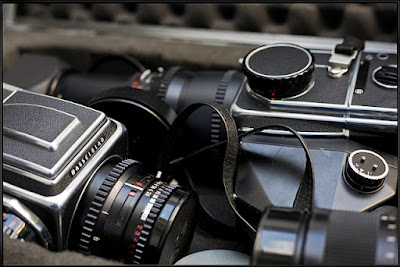 Part of our old Hasselblad system in its case
Part of our old Hasselblad system in its caseMany of us photographers get a little carried away with all the cool gadgets, equipment and cameras. We end up with lots of stuff – sometimes causing mild distress to our partners. Fortunately my wife is also a photographer although she takes a very practical approach to equipment. I’m definitely the Magpie in our family.
So I’ve ended up with truck loads of cameras and gadgets. And guaranteed when I open a photo magazine tomorrow I’ll see something else that ‘I need’. I’m sure that many of my readers will be nodding their heads wistfully at this stage. All sounds a bit familiar eh.
But sometimes all of this stuff can get in the way of good photography. I remember seeing a photographer in the street a while back with a backpack, a camera bag in each hand and a tripod, and two cameras dangling round his neck. The poor chap could hardly move, never mind capture the action on the street. He decided to go for a tripod shot and then spent 15 minutes struggling with various bits and pieces on his tripod and changing lenses – opening this bag and then that one, shifting things around. In the meantime several really interesting people walked by but he had his head down busy with his stuff. I stood there and shook my head in wonder. After 15 minutes of watching him fussing and not taking a single shot, I gave up and wandered off.
So what should you take with you on a photo-shoot. Well it very much depends on what you want to do. If you’ve got a big production ala Annie Liebowitz then you’ll need an articulated lorry. If you’re into flash and bringing your own light to the party like David Hobby or Joe McNally then a few bags of flashes and lighting paraphernalia are the norm. For photojournalists like James Nachtwey a camera and a 28-70 F2.8 will do nicely, or Steve McCurry – travelling light with his camera and three fixed lenses. Cartier Bresson famously took most of his images on his Leica with a standard lens.
The key questions to ask yourself are:
- What type of image am I after?
- What is the environment going to be like?
- Will I have somewhere to leave my equipment safely or will I need to travel light and move fast?
- What is going to cause me more hindrance than it is worth?
- If I leave xyz behind will that kill my chances of getting a good shot?
Here’s another tip for you. If you’re travelling and don’t want to risk lots of expensive equipment in the aircraft hold then you may want to investigate hiring stuff when you arrive on location. It can save a lot of headaches.
Till soon,
Paul
www.indigo2photography.co.uk
Follow me on twitter
Comments
Don't sweat about having too much equipment: boys need their toys!
I rarely walk with my bag full of stuff nowadays. Typically, I choose one lens; although I may miss some opportunities, I also gain by taking shots that otherwise I would not have taken. I can also be a contrarian by taking a 70-200 downtown. I find this is a nice way to force oneself thinking outside the box.
Cheers!
the folks who move past this stage realize that in the end it is about the image, and generally pare down their kit to the essentials, because really - who wants to carry 500lbs of gear everywhere?